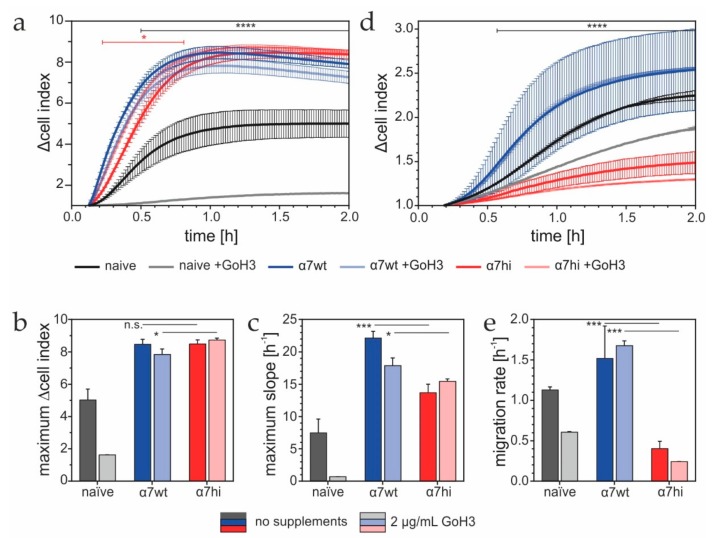Figure 4.
Adhesion and migration of HT1080 cells expressing integrin α7wt and α7hi. (a) Adhesion to laminin-111of naïve and transfected HT1080 cells in an E-plate of the xCELLigence DP device. Cells expressing α7wt or α7hi adhered faster and with a higher saturation signal than the naïve HT1080 cells. Adhesion via α6β1 integrin was challenged by adding the antibody GoH3. (b) Maximum adhesion signals and (c) maximum slope, indicating the maximum adhesion rate, were compared for at least three independent experiments. Means ± SD are shown. (d) Haptotactic migration toward laminin-111 of HT1080 cells was recorded in a CIM plate of the xCELLigence DP device. Cells expressing α7hi moved much slower than α7wt transfectants and naïve cells. (e) The migration rates were determined as change of Δcell index values over time, between 30 and 60 min. Experiments were performed in Tyrode’s solution. Means ± SD of a quadruplet determination of one out of three experiments are shown. The data in (a) and (d) were compared for the effect of GoH3 by two-way-ANOVA with multiple comparison correction via the Holm–Sidak method. Time periods with significant differences are marked in the corresponding color of the cells. As only the naïve HT1080 showed significant changes upon GoH3 treatment after 1 h, the comparison bars for comparing the GoH3-free vs. GoH3-treated samples are omitted in (b), (c) and (e). In the same plots, comparison bars are only shown for the comparison of α7wt vs. α7hi transfectants and are based on pairwise comparisons with Student’s t-test. Significance levels: * p ≤ 0.05; ***. p ≤ 0.005; ****, p ≤ 0.001.

